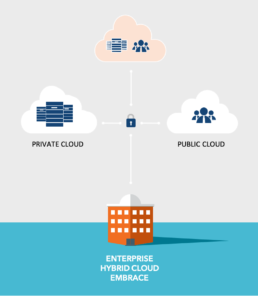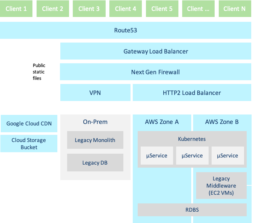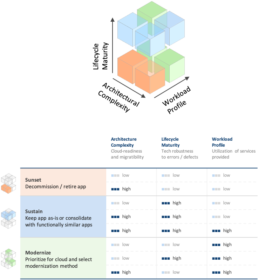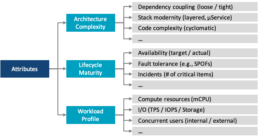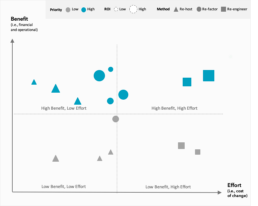THE JOURNEY HAS ONLY BEGUN
Over the past decade, we have seen a widespread infrastructural shift from physical hardware to virtual machines (VMs), and recently to containers and the public cloud (e.g., AWS, Azure, GCP).1 Companies are in a race to maximize agility, bolster resilience, and reduce costs. Examples of this are pervasive across the market: large financial services players like Blackrock, CapitalOne, ING, and others have already made significant progress towards building out their capabilities. CapitalOne, for instance, exited all on-prem data centers by migrating to AWS, enabling instant architectural provisioning.2 As enterprises double down on the digitization of mission-critical processes to support their customers during Covid-19, reliance on the cloud is not only accelerating but is fundamentally changing in nature.
Despite the undisputed benefits, only recently has the lens shifted from focusing on individual proof of concepts (POCs) towards considering comprehensive application portfolios. Services are transitioning from monolithic and rigidly stitched architectural designs to interconnected webs of microservices, rendering phased transitions possible.2 Organizations around the globe are increasingly adopting cloud-native strategies to deliver on users’ demand for innovative, real-time services in a manner that overcomes the hurdles that have otherwise stymied full realization of benefits.
While there are several notable examples of companies reaping substantial rewards from this paradigmatic shift, it is vital to realize that the successful enterprise embrace of cloud-native is not without challenges. Teams across organizations often work in isolation on migration initiatives, leading to fragmented architecture and significant deviance from cloud-first design standards. At the same time, migrations are often executed ad-hoc and are driven by individual functional needs instead of procedurally stemming from holistic data-driven app portfolio assessments. This approach forestalls the ability to rationalize several apps concurrently, to effectively prioritize between them, and to capture both tangible and intangible benefits from each migration. These challenges are further complicated by operational ambiguities with regards to ownership and skill gaps for cloud development.
A holistic and streamlined approach to cloud-native transformation can accelerate migration initiatives and reduce implementation complexity. To maximize value, CIOs must develop a strategy for a hybrid ecosystem target state design, facilitate data-driven portfolio rationalization, comprehensively quantify transformation benefits, and define a repeatable execution framework for service owners.
PROGRESS IS WELL UNDERWAY
At its core, a cloud-native app consists of a collection of small and independent microservices (Exhibit 1) that are loosely linked through APIs and deployed in containers. Each service implements a business capability and is delivered using DevOps practices that automate both CI/CD and quality testing, enabling dynamic infrastructure scaling and reducing cost
While the shift to cloud-native is novel, the technology and associated decentralized mechanisms are not nascent. In the past five years, forward-looking organizations have made significant strides toward leveraging this rapidly maturing paradigm, spurring new products, processes, and cooperative alliances. For example:
– The Cloud-Native Computing Foundation (CNCF) was founded in 2015 by a confederation of members that included Google, Twitter, IBM, Intel, and Docker to advance the adoption of containers and help formulate industry best-practices for cloud-native standards and principles.
– Containerization, a central aspect of the US Department of Defense’s modernization plan, allows the agency to reduce time to app deployment from 23 days to less than 5 hours, and to bring the time to issue closure down from 30 days to 1 day.
Exhibit 1: Microservice-based architecture
Microservices are independent, dynamically scalable capabilities that are loosely coupled together to make up an application.
– Walmart Canada moved to a microservices architecture and, as a result, experienced a 20 percent increase in conversions, a 98 percent rise in mobile orders, zero downtime on Black Friday and Boxing Day, and a 40 percent reduction in required computing power.
– Adobe launched a cloud-native CMS offering so clients could provide their end-customers with scalable, real-time, customized content, resulting in a 50 percent faster ingestion time, a 40 percent increase in administrative efficiency, zero downtime from regularly scheduled updates, and a more than 20 percent surge in authors’ productivity.
– While 21 percent of financial institutions currently use hybrid cloud environments, Alibaba affiliate Ant Financial containerized all core financial services in 2017 to provide real-time storage, computing, and processing for its 900 million users worldwide.
Not only does the adoption of cloud-native enable a wide array of benefits, but it also has ramifications for how IT departments function. Essentially, this new paradigm promotes an evolution of IT that allows it to overcome historical constraints and re-position itself as a value-creator for the business. No longer are IT organizations to be distant silos that simply manage systems on the back-end.
BEYOND FINANCIAL BENEFITS
Cloud-native development remedies the long-standing tension between keeping systems stable and secure while continually changing processes to deliver new functional benefits. The trade-off between reliability and evolving functionality leaves IT teams with the constant struggle to balance the ability to address short-term needs with the progression toward longer-term aspirations. However, a dedicated embrace of cloud-native strategies can enable global organizations to remain competitive in terms of minimizing downtime and customer disruption, as well as bolstering the speed of app development and maximizing their flexibility in meeting changing business needs.
Cloud-native development allows for the building and updating of apps quickly and efficiently, as more granular components of apps can be revamped. This approach reduces risk and promotes fault tolerance, as updates no longer necessitate re-working the entire app.
Containerization thus facilitates reproducibility, transparency, and resource isolation. Containers run through virtual environments and become isolated from their original environments so that they are independent and portable. Ultimately, this approach transfers the app servers’ orchestration capability to the container management layer.
Reaping these benefits requires businesses to undertake comprehensive transformations of pre-existing processes and technologies. Currently, many workloads are stuck in traditional environments that are costly to maintain, complex to manage, and often laden with technical debt. The path forward requires traditional middleware to be refactored in a manner that leverages microservices, APIs, and containers. IT leaders are responding to the challenge by earmarking ever-increasing investments into cloud-oriented transformations and by building out the required internal capabilities to navigate and accrue value from the ongoing shift to cloud-native architecture.
Of course, increased spending will not be the silver bullet. The refactoring of apps into services will require stakeholder engagement, a systematic rationalization of the app portfolio driven by business cases and needs, and vendor collaboration and oversight. Therefore, direction from business and operation teams, as opposed to only technical expertise, will be central to driving these initiatives forward.
WHAT “GOOD” LOOKS LIKE
1. Target State Architecture
Hybrid ecosystem design is often complicated due to the absence of enterprise standards for cloud-native design patterns, which leads to fragmented architecture. Reliance on the services of a single cloud provider can lock you into their platform, which stymies flexibility and derails multi-cloud compatibility. Thus, a provider-agnostic framework must be defined to enable seamless data transfer, access management, and network integration between retained on-prem assets and public cloud components.
Formulating a target state cloud architecture for enterprises first requires teams to assess the current app dependencies. Then, it becomes critical to identify operational gaps and validate the support model. Considering these assessments, teams must define unified configuration schemas for integration with on-prem and multiple CSPs. This approach requires establishing consistent identity & access management (IAM) policies to define individual permissions, networking configurations that start from a zero-trust premise, compute and attached storage policies (e.g., component and scaling configurations, encryption, backups, purging), and a pre-approved list of CSP offerings and preferred availability zones. Together, these policies constitute a referential architecture blueprint, which will accelerate design efforts for app teams, and ensure that early plans crafted are compatible with key security and operational frameworks.
Exhibit 3: Target Cloud Architecture Design (example)
Note: The diagram above is illustrative; architectural layouts will differ depending on the enterprise and the Cloud Service Providers (CSPs) used
2. Portfolio Prioritization
Currently, the process of selecting and prioritizing applications for migration is often conducted in an ad-hoc, isolated fashion and is driven by specific feature or availability requirements. As a result, a limited number of portfolio-level assessments are conducted. Furthermore, data-driven scoring is rarely used. This cherry-picking approach does not lend itself well for maximizing the overall ROI and does not ensure alignment with the enterprise’s strategic priorities.
Prioritization should result from determining the go-forward strategy for each application within a service portfolio (i.e., retire, sustain, modernize), as well as the subsequent selection of the ideal modernization method (i.e., re-host, re-factor, re-platform) for each application.
Rationalization of apps and the selection of modernization methods require an analytics-based portfolio assessment. Key data attributes related to architecture complexity, lifecycle maturity, and workload profile should be part of a holistic scoring framework. The exact attributes that make up these three parameters and their respective weights will differ across organizations, depending on the enterprise’s strategic priorities and needs. App composite scores across these three parameters inform their respective go-forward strategy, as depicted in Exhibit 3. (e.g., sunset apps that score low on all three, sustain apps scoring high on all three, modernize those with low complexity but high lifecycle maturity and workload profile).
Exhibit 3: Framework for App Scoring and Strategy
Examples of such attributes include:
Finally, the modernization method selected must be reflective of the needed refactoring. This decision is based on the underlying complexity and modernity of the tech stack. For example, monolithic apps must be re-engineered into microservices before migration. On the other hand, apps that are already modern in design and are comprised of containerized microservices may simply need to be re-hosted or “lifted-and-shifted” with minimal effort.
3. Benefits Planning
Business case development for app migrations tends to have a narrow focus on cost savings. Often this process does not account for intangible benefits of operational outcomes like improved resiliency. A holistic analysis (Exhibit 4) must include both tangible cost savings as measured through run rate reductions post-migration, and intangible improvements like increased resiliency, agility, and maintainability.
Adequate financial forecasting of financial benefits requires the ability to attribute current state expenses to individual applications (i.e., TCO), as opposed to a consolidated portfolio. Additional hidden cost, such as overheads (e.g., energy, space), workforce training, and periodic certifications need to be considered as well.
Exhibit 4: Sizing transformation effort and benefits
It is also important to realize that run costs can increase in the short-term as app teams continue to pay for on-prem vendor services until multi-year contracts expire (or are renegotiated). Thus, true run rate savings may not be realized for years after an app has been migrated.
At the same time, to fully capture migration benefits, it is important to quantify the financial impact of intangible benefits such as higher operational resiliency, greater staff productivity, and increased business agility. For example, higher resiliency leads to reduced unplanned downtime, which minimizes potential revenue loss. Greater productivity allows for FTE rationalization yielding labor savings. Concurrently, increased agility means faster deployments and product launches that reduce time to revenue and user input. These considerations must be quantitatively factored into any benefits analysis to formulate an accurate picture of the migration benefits and ROI, and to create the full business case.
4. Migration Execution
Given all the challenges enterprises face, it is vital to outline a clear execution approach that is swift and reduces complexity. Existing approaches for migration often result in protracted timelines due to activity and ownership ambiguities. The situation is further complicated by internal skill gaps, given the relatively new set of expertise required for navigating hybrid cloud environments. These pertinent challenges obscure the tracking of meaningful progress and derail mechanisms for maintaining accountability, thereby increasing the likelihood of missteps.
Any errors made during the execution phase are not only costly from a time perspective but also diminish the overall migration benefits and ROI as these errors increase costs and exacerbate opportunity costs. They also prolong adverse effects on users while execution efforts are underway, affecting both reputation and top-line growth.
Cloud migrations require a comprehensive understanding of the granular tasks as well as the relevant key stakeholders. Equally important is the explicit definition of critical milestones that ensure operational validation and completion for each execution phase. A comprehensive execution framework that outlines the specific steps that app teams must take to ensure readiness for the cloud is critical. Additionally, such a framework should specify key gating criteria to fast-track budgetary approval and underscore where exactly the input of external stakeholders is required for a host of considerations. This includes topics such as security, design, strategic growth, and technical feasibility.
This kind of repeatable framework should be socialized with portfolio owners to drive continuous improvement and help foster a critical mass of migrations for the enterprise. Earlier migrations will require greater effort to execute as standards are formulated and a greater number of on-prem dependencies exist. Over time, as a critical mass of migrations is achieved, each subsequent migration will require less incremental effort and will allow for faster realization of benefits.
IN CLOSING…
As customer-facing digitization and the pace of internal and external user demands accelerate, enterprises will increasingly leverage public cloud environments to remain competitive. This trend, coupled with technological developments such as container-based and service-oriented architecture, has led to a fundamental change in how the cloud is viewed; namely, from a location to a “cloud-native” first for design and deployment.
This shift has caused a significant potential for reducing costs and bolstering agility: large financial services can leave the innovation and stability trade-off behind by focusing on their competitive advantage of building exciting, customer-centric products, rather than internally running ever larger IT groups.
To capture the latent value of cloud-native, organizations must allocate resources and facilitate stakeholders to formulate (1) a sound target state (hybrid) cloud architecture, (2) a data-driven app scoring methodology, (3) a comprehensive methodology for benefits quantification, and (4) an end-to-end cloud-specific implementation framework. Organizations embracing the cloud-native paradigm and experimenting with containerization and microservices are most likely to capture disproportionate gains and solidify their competitive edge over the next decade.

